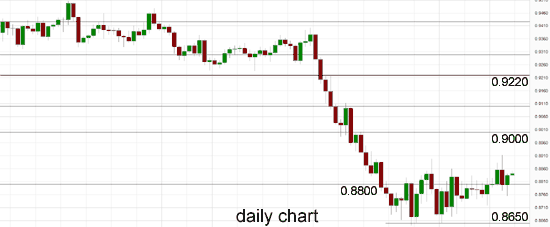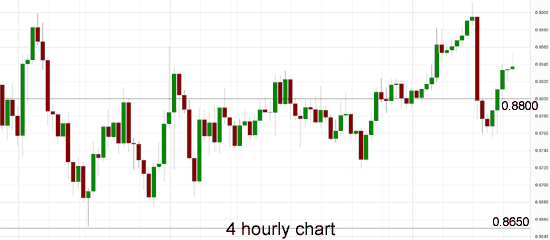In the last 24 hours or so the Australian dollar has rallied again back up through the resistance level at 0.88 after only recently falling sharply back down through that level in the day prior. It had only just reached a two week high just above 0.89 before the sharp fall. During the last month the Australian dollar has done well to stop the bleeding and trade within a wide range roughly between 0.8650 and 0.88. Prior to that it had experienced a sharp decline throughout September which saw it move from close to 0.94 down to below 0.8650 and an eight month low in the process. The resistance level at 0.88 remains a factor and is continuing to place downwards pressure on price, however more recently all eyes have turned on to the support level at 0.8650 to see if the Australian dollar can remain above it. Several weeks ago the Australian dollar found some much needed support at 0.8950 and rallied back up to just shy of the key 0.90 level before resuming its decline. The long term key level at 0.90 was called upon to desperately provide some much needed support to the Australian dollar, which it did a little a few weeks ago, however it has more recently provided resistance.
Back at the beginning of September the Australian dollar showed some positive signs as it surged higher again bouncing off support below 0.93 and reaching a new four week high around 0.94 however that all now seems a distant memory. The Australian dollar reached a three week high just shy of 0.9480 at the end of July after it enjoyed a solid period which saw it surge higher through the resistance level at 0.9425 to the three week around 0.9480, before easing back towards that level. The Australian dollar enjoyed a solid surge higher reaching a new eight month high above 0.95 at the end of June, only to return most of its gains in very quick time to finish out that week. Since the middle of June the Australian dollar has made repeated attempts to break through the resistance level around 0.9425, however despite its best efforts it was rejected every time as the key level continued to stand tall, even though it has allowed the small excursion to above 0.95.
After the Australian dollar had enjoyed a solid surge in the first couple of weeks of June which returned it to the resistance level around 0.9425, it then fell sharply away from this level back to a one week low around 0.9330 before rallying higher yet again. Its recent surge higher to the resistance level around 0.9425 was after spending a couple of weeks at the end of May trading near and finding support at 0.9220. Throughout April and into May the Australian dollar drifted lower from resistance just below 0.95 after reaching a six month high in that area and down to the recent key level at 0.93 before falling lower. During this similar period the 0.93 level has become very significant as it has provided stiff resistance for some time. The Australian dollar appeared to be well settled around 0.93 which has illustrated the strong resurgence it has experienced throughout this year.
Australia’s terms of trade slide continued in the September quarter. The terms of trade is a measure of Australia’s luck. It’s the ratio of export prices to import prices, so it’s a gauge of whether Australia is having to sell more tonnes of coal or bales of wool in order to buy a given quantity of plasma televisions, cars, dresses or smart phones. And, it turns out, it is. The import price index fell by 0.8 per cent in the September quarter, according to figures from the Australian Bureau of Statistics on Thursday. But the export price index dropped by 3.9 per cent, continuing the pattern seen since mid-2011. Since then, the price of exported goods has fallen by 23 per cent relative to import prices. Or, to put it another way, for every tonne, bale, ounce or bushel of stuff Australia had to export in order to buy a load of imports in 2011, it now has to export 1.3 tonnes, bales, ounces or bushels to pay for the same bundle of imports. The national accounts, the source of estimates of gross domestic product (GDP), have a broader measure of the terms of trade – it includes trade in services like travel and tourism. It’s very likely to show a similar result for the September quarter.
(Daily chart / 4 hourly chart below)
AUD/USD October 30 at 22:10 GMT 0.8836 H: 0.8853 L: 0.8831
AUD/USD Technical

During the early hours of the Asian trading session on Friday, the AUD/USD is trying to hold on to the resistance level at 0.88 after recently falling sharply back down through there. The Australian dollar was in a free-fall for a lot of last year falling close to 20 cents and it has done very well to recover slightly to near 0.95 again earlier this year. Current range: trading right around 0.8830.
Further levels in both directions:
- Below: 0.8650.
- Above: 0.8800, 0.9000, and 0.9100.
Recommended Content
Editors’ Picks
EUR/USD clings to marginal gains above 1.0750

EUR/USD trades in positive territory above 1.0750 in the second half of the day on Monday. The US Dollar struggles to find demand as investors reassess the Fed's rate outlook following Friday's disappointing labor market data.
GBP/USD edges higher toward 1.2600 on improving risk mood

Following Friday's volatile action, GBP/USD pushes higher toward 1.2600 on Monday. Soft April jobs report from the US and the modest improvement seen in risk mood make it difficult for the US Dollar to gather strength.
Gold rebounds above $2,310 as US yields push lower

Gold price trades in positive territory above $2,310 in the American session on Monday. The benchmark 10-year US Treasury bond yield stays in the red below 4.5% after weaker-than-expected US employment data, helping XAU/USD hold its ground.
Addressing the crypto investor dilemma: To invest or not? Premium

Bitcoin price trades around $63,000 with no directional bias. The consolidation has pushed crypto investors into a state of uncertainty. Investors can expect a bullish directional bias above $70,000 and a bearish one below $50,000.
Three fundamentals for the week: Two central bank decisions and one sensitive US Premium

The Reserve Bank of Australia is set to strike a more hawkish tone, reversing its dovish shift. Policymakers at the Bank of England may open the door to a rate cut in June.

